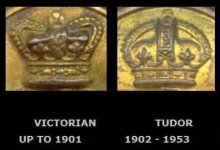This 2-piece brass button was found by a friend on a homestead site in Ontario. It has a crown, a ‘V’ and a wreath on the front and the back-mark says, ‘Extra Rich Orange’.
If anybody can tell me anything about it or can identify what it is, your information would be appreciated.

Thanks,
Dave









